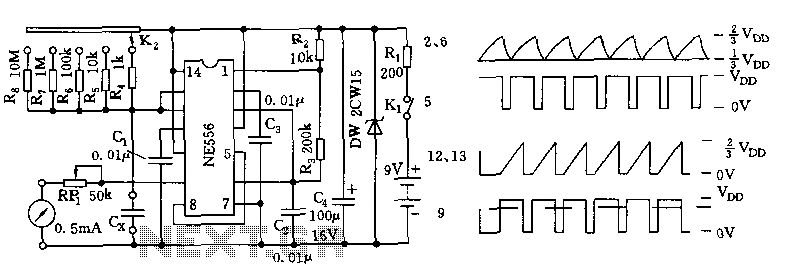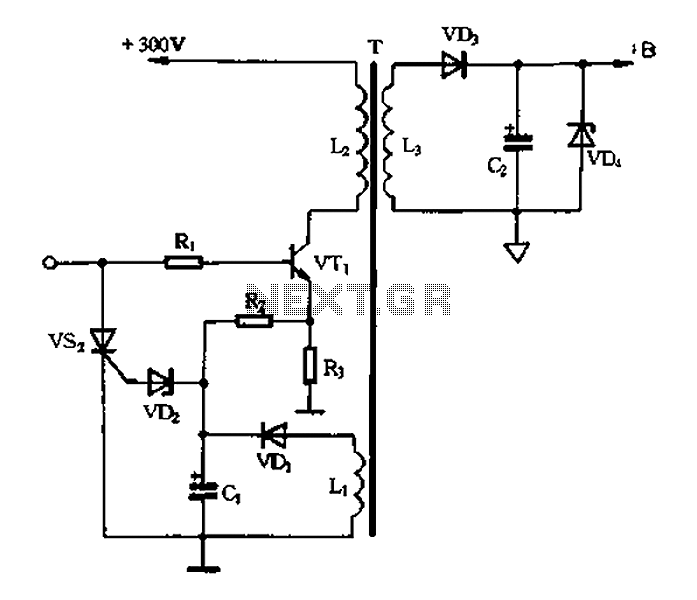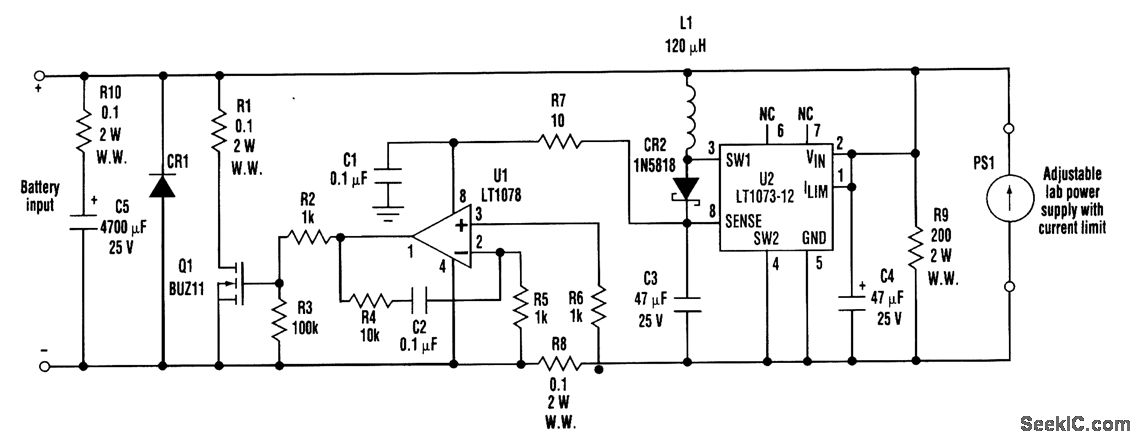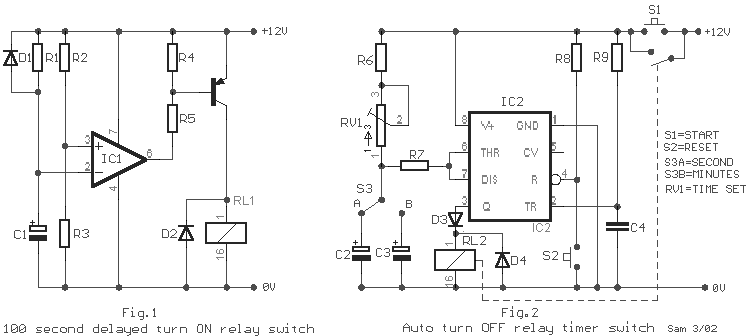
555 capacitance tester circuit diagram

The tester comprises a dual time base circuit using a 556 timer and various RC components. The right side of the circuit features the 556 timer (556 1/2) along with resistors R2, R3, capacitors C2, C3, and additional components configured as an astable multivibrator. The oscillation frequency is calculated using the formula f = 1.44 / ((R2 + 2R3) * C2), which corresponds to a frequency of approximately 60Hz. The left side of the 556 timer (556 1/2) includes capacitor C4, range resistors R4 through R8, and the measured capacitance Cx, forming a one-shot trigger circuit. The output of the right half produces a low-level square wave output for a duration determined by the one-shot pulse width, which is influenced by the range resistors R4 through R8 and the capacitance Cx, expressed as t = 1.1 * (R4 ~ R8) * Cx. Different capacitance values for Cx allow for the selection of varying measurement ranges. The output level from pin 9 of the 556 timer changes according to the measured capacitance Cx, and a potentiometer RP1 is connected to a milliampere (mA) current meter or multimeter for calibration purposes. The RP1 potentiometer is used for correction and full-scale calibration with standard capacitance values. The waveform diagrams for each pin of the 556 timer are illustrated in Fig. B. This circuit can measure capacitances ranging from 10pF to 1µF, with distinct ranges of 10pF, 100pF, 1000pF, 0.01µF, 0.1µF, and 1µF, corresponding to current ranges of 100µA to 0.5mA.
The described tester circuit utilizes the 556 timer, which contains two independent timing circuits that can be configured in various ways. The astable multivibrator configuration on the right side of the circuit generates a continuous square wave signal. The frequency of oscillation is determined by the resistors and capacitors connected to it, allowing for precise timing control. The use of R2 and R3 in the formula for frequency highlights the relationship between resistance and capacitance in determining the oscillation rate, which is critical for accurate capacitance measurement.
On the left side, the one-shot circuit is essential for generating a pulse in response to the square wave output. The duration of this pulse is governed by the selected range resistors R4 to R8 and the capacitance Cx being measured, providing flexibility in measurement capabilities. The inclusion of a potentiometer (RP1) for calibration ensures that the measurements can be fine-tuned against known capacitance standards, enhancing the accuracy of the tester.
The circuit is capable of measuring a wide range of capacitance values, which is particularly useful in electronics for testing capacitors in various applications. The clear division of measurement ranges enables users to select the appropriate setting for the capacitance being tested, ensuring that the circuit operates within optimal parameters. The output current range from 100µA to 0.5mA indicates the circuit's ability to handle different capacitance levels, making it a versatile tool for engineers and technicians working with electronic components.The tester consists of an dual time base circuit 556 and a number of RC components and other components. Illustrated by the right half of the circuit 556 (556 1/2) and R2, R3, C2, C3 and other components astable multivibrator, the oscillation frequency f = 1.44 / (R2 + 2R3) C2. Parameters correspond icon the frequency of about 60Hz or so. The left half of 556 (556 1/2) and C4, range resistors R4 ~ R8 and measured capacitance Cx constitute one-shot trigger circuit, 5 feet at the low level period of the square wave output of the right half, monostable flip, one-shot pulse width depends on the range resistors R4 ~ R8 and Cx, ie, t = 1.1 (R4 ~ R8) Cx.
According to the measured capacitance Cx select a different size range. Cx different capacities, the 556 9-pin output level correspondingly different, after potentiometer RP1 connected mA current file table or multimeter. RP1 potentiometer for the correction, for full-scale calibration with standard capacitance. 556 feet of each waveform diagram shown in Fig. B. This circuit can be measured capacitance of 10pF ~ 1uF within range. Range divided 10p ~ 100p ~ 1000p ~ 0.01u ~ 0.1u ~ 1u, corresponding to the current range of 100uA ~ 0.5mA.
The described tester circuit utilizes the 556 timer, which contains two independent timing circuits that can be configured in various ways. The astable multivibrator configuration on the right side of the circuit generates a continuous square wave signal. The frequency of oscillation is determined by the resistors and capacitors connected to it, allowing for precise timing control. The use of R2 and R3 in the formula for frequency highlights the relationship between resistance and capacitance in determining the oscillation rate, which is critical for accurate capacitance measurement.
On the left side, the one-shot circuit is essential for generating a pulse in response to the square wave output. The duration of this pulse is governed by the selected range resistors R4 to R8 and the capacitance Cx being measured, providing flexibility in measurement capabilities. The inclusion of a potentiometer (RP1) for calibration ensures that the measurements can be fine-tuned against known capacitance standards, enhancing the accuracy of the tester.
The circuit is capable of measuring a wide range of capacitance values, which is particularly useful in electronics for testing capacitors in various applications. The clear division of measurement ranges enables users to select the appropriate setting for the capacitance being tested, ensuring that the circuit operates within optimal parameters. The output current range from 100µA to 0.5mA indicates the circuit's ability to handle different capacitance levels, making it a versatile tool for engineers and technicians working with electronic components.The tester consists of an dual time base circuit 556 and a number of RC components and other components. Illustrated by the right half of the circuit 556 (556 1/2) and R2, R3, C2, C3 and other components astable multivibrator, the oscillation frequency f = 1.44 / (R2 + 2R3) C2. Parameters correspond icon the frequency of about 60Hz or so. The left half of 556 (556 1/2) and C4, range resistors R4 ~ R8 and measured capacitance Cx constitute one-shot trigger circuit, 5 feet at the low level period of the square wave output of the right half, monostable flip, one-shot pulse width depends on the range resistors R4 ~ R8 and Cx, ie, t = 1.1 (R4 ~ R8) Cx.
According to the measured capacitance Cx select a different size range. Cx different capacities, the 556 9-pin output level correspondingly different, after potentiometer RP1 connected mA current file table or multimeter. RP1 potentiometer for the correction, for full-scale calibration with standard capacitance. 556 feet of each waveform diagram shown in Fig. B. This circuit can be measured capacitance of 10pF ~ 1uF within range. Range divided 10p ~ 100p ~ 1000p ~ 0.01u ~ 0.1u ~ 1u, corresponding to the current range of 100uA ~ 0.5mA.





